“Wondering why people haven’t questioned the story of Capa’s D-Day film … Why bother? People like the story. And it’s a better story than that Capa bugged out after snapping only 11 frames, if that’s what happened.” — John Loengard, ex-LIFE staff photographer turned author and LIFE historian, News Photographer, January-February 2015, p. 56.
•
As described in my previous post, the September 1944 quickie book Invasion! by Charles Wertenbaker, illustrated with pictures by Robert Capa, marked the public debut of the myth of a darkroom accident in LIFE‘s London office destroying most of Capa’s Omaha Beach D-Day photographs, along with its corollary — that in order to make all those nonexistent exposures Capa had spent a lot more time there than he actually did.
Though not published by TIME/LIFE (which did not yet have a book division), this slim volume, authored by TIME’s foreign editor and a senior correspondent for all the corporation’s magazines, with illustrations by its new high-profile staff photographer (reproduced by explicit permission of LIFE), tacitly put the corporate imprimatur on a generalized version of the myth. (The specific darkroom error went unspecified.) Yet it would take decades for TIME/LIFE to decide to fold this myth into the organization’s larger, encompassing history and thereby lend their substantial reach and influence to its promulgation.
•
That, by the time Capa published Slightly Out of Focus in 1947, this fable of darkroom ineptitude and melted emulsion also circulated anecdotally is undeniable. Ingrid Bergman had heard it from Capa, her lover for several years; she repeats it verbatim in her autobiography, My Story, published in 1980. Hollywood director Sam Fuller had heard it from Capa as well; in his memoir A Third Face: My Tale of Writing, Fighting, and Filmmaking (2002) he recalls it when describing a 1947 meeting with Capa in Hollywood, which took place, according to Fuller, while the photographer worked on his own memoir. But if the upper echelon of LIFE magazine or its parent corporation took notice of either the anecdotal or published versions and cared in any way, they clearly decided to ignore it, in the hope that it would go away.
They judged correctly. No one ever took LIFE to task — nor John Morris (Capa’s picture editor in London), nor darkroom chief “Braddy” Bradshaw, nor even the then-anonymous “darkroom lad” — over the supposedly lost negatives; everyone appears to have chalked the incident up to “the fog of war.” The unsourced statement attributed much later to Capa — “I would never have worked for LIFE again if they had fired Dennis Banks for ruining my negatives” — appears apocryphal, most likely fictional. So does Morris’s vague variant on that theme in his summer 2014 interview with Mark Edward Harris for the magazine Black & White:
“Some people thought he [Banks] should have been fired, but neither Capa nor I would have stood for that. He continued to work for LIFE for a number of years after that. I actually saw him at the bureau in 1953, which was the first time I visited the offices after the war.”
Nor did Capa’s self-protective charge that LIFE had used the seawater excuse to cover up its role in the purported accident affect the magazine’s reputation. With the war just over and won, people moved on, bypassing the scrutiny that would come about with distance from the events.
No one at LIFE held those accusations against Capa; indeed, once he returned to freelancing he continued to get lucrative assignments from them, including his very last. LIFE‘s obituary tribute to Capa, “A Great War Reporter and His Last Battle” (June 7, 1954 — a decade and a day after the Normandy landing), reproduces “The Face in the Surf” on p. 29, indicating incorrectly in the caption that “The landing on D-Day brought Capa in with the first wave,” while tactfully making no mention of the fate of his negatives.
•
In 1950 Wilson Hicks, chief picture editor in the magazine’s New York office on D-Day, left as well. John Shaw Billings, LIFE‘s Managing Editor on D-Day, retired in 1954. Hans Wild, present in the London darkroom that night, died in 1969, having never spoken on the record about the processing of Capa’s negatives. (Morris didn’t name him in his narrative of those events until well after Wild’s demise, when he could no longer deny it.) Hicks died in July 1970. Larry Burrows, there that night in his role as “tea boy,” died in 1971. Unnamed by Morris up till then in any published accounts of the events of the night of June 7 and the morning of June 8, London darkroom chief “Braddy” Bradshaw and “darkroom lad” Denis Banks had become effectively untraceable. So, by January 1971, no one connected with LIFE‘s D-Day issue held any position at the magazine. And Capa’s memoir, Slightly Out of Focus, had long since gone out of print.
What, then, kept the fable of the melted emulsions alive? Or, more precisely, who? In a nutshell, Cornell Capa and John Morris, whose roles in perpetuating this myth I will address in due time. More to the point of the present analysis, exactly when did TIME/LIFE, Inc. elect to join them in furthering the legend?
I have found it difficult to pinpoint this, in large part because the corporation has had so many opportunities to so: books, D-Day memorial issues and one-off commemorative publications, films and videos, eventually its website. I lack the resources to identify them all, much less track them down. Still, I can give some indication of where the myth of Capa’s 90-minute stay on Omaha Beach and the subsequent melted emulsion doesn’t appear:
• Life’s Picture History of World War II (New York: Time Inc., 1950). This book uses only one Capa D-Day image, a detail of his seventh exposure (negative no. 35), showing Demolition Unit 10 at work. While identifying them correctly as engineers, the caption misrepresents their activity (it has them hiding from enemy fire).
• LIFE Managing Editor George P. Hunt’s April 11, 1969 editor’s note on staffer John Olson winning the National Press Club’s Capa Award for a LIFE feature on the battle of Hué in Vietnam.
• The 1971 Photojournalism volume of the hardcover series Life Library of Photography, for which “The Editors of Time Life Books” receive authorial credit, with one Jerry Korn listed as editor, represents Capa with the 1936 VU story where “The Falling Soldier” first appeared. The accompanying text claims that “Capa himself continued to get close, swimming ashore with the first assault wave” on D-Day, but does not mention the darkroom disaster.
• Life Goes to War: A Picture History of World War II (Time-Life Books, 1977), edited by David E. Scherman, has two pages of Capa images (pp. 237-38) but no mention of the darkroom incident.
• With curious reticence, John Loengard elides any mention of the darkroom disaster in his account of the making of “The Face in the Surf” in his book LIFE Classic Photographs: A Personal Interpretation (Boston: New York Graphic Society, 1988), p. 31.
• Life Commemorative — D-Day: The 60th Anniversary (June 1, 2004) reproduces in facsimile the first 7 pages of “Beachheads of Normandy,” the feature that leads off with Capa’s Omaha Beach photos, but does so with no additional commentary.
•
Without claiming that I have identified TIME/LIFE’s first embrace of the myth and all subsequent endorsements thereof, I have found it in the following locations:
• The Second Front (World War II), by Douglas Botting, published by Time-Life UK in 1978 as part of a series on the war. Repeats the standard story from Slightly Out of Focus re Capa landing with the first wave, etc. “[Capa] had made 106 pictures in all. His three rolls of film were rushed to LIFE’s London office for processing. There a darkroom technician, eager for glimpses of the landing, dried the film too fast. The excessive heat melted the emulsion and ruined all but 10 frames.” (P. 144)
So, 41 years after Capa went full-scale public with John Morris’s emulsion-melt fiction if not earlier, TIME/LIFE opted to buy into it and own it. (After all, it was theirs to claim all along.) This book had a revised second edition under this title in 1985, and then a retitled third edition — The D-Day Invasion — in 1998, all from Time-Life Books.
• John Loengard, Celebrating the Negative (Arcade Publishing, 1994). Not precisely a TIME/LIFE publication, but I include it here because it supports the position articulated in this post’s epigram by its author, ex-LIFE staffer and subsequent LIFE historian Loengard. His role as an historian notwithstanding, Loengard in 2015 would declare himself an unabashed and enthusiastic advocate of the myth over any other version of the story, truth be damned.
The book includes his photo of Cornell Capa’s hands — his left white-gloved, his right bare — with the remaining eight of Capa’s original ten Omaha Beach negatives: a collaboration between two experienced old-school photographers who know perfectly well that 35mm b&w emulsion doesn’t melt, yet opt to consciously perpetuate the myth — Loengard on behalf of TIME/LIFE, Capa on behalf of the International Center of Photography. With a deadpan recap by Loengard of the fiction.
• TIME‘s commemorative book D-Day: 24 Hours That Saved the World, first published in 2004, offers this on p. 125: “Robert Capa shot all his film at Omaha Beach, then made his way to England on a medical craft to deliver it. But an overeager assistant in the LIFE picture bureau in London, rushing to see the shots, overheated the film, spoiling 98 of Capa’s 106 images. The guilty assistant was Larry Burrows, who later became a great combat photographer in his own right …” Wrong in every particular. (This book has already gone through two reprint editions, one in 2009, the other in 2014; apparently TIME intends to reissue it, unchanged, on every 5-year anniversary of the battle.)
• TIME‘s embrace of the myth continued in “The Iconic Photo of D-Day,” the 65th D-Day anniversary video they commissioned in 2009 from independent producer Craig Duff, various errors in which I annotated in this July 1, 2014 post.
• Fully on board now, TIME/LIFE went full-tilt boogie on the myth for the septuagennial celebration. To the 2014 reprint of the TIME book D-Day: 24 Hours That Saved the World, described above, they added a new tome, LIFE‘s own commemorative, D-DAY: 70 Years Later — Remembering the Battle That Won the War. This has a text by Douglas Brinkley, in which he writes,
“There is very little about D-Day that is ironical, but irony attaches to Capa’s 11 surviving images. As mentioned, his film underwent a hazard when being processed in London. Most shots were ruined and the others were what might be called damaged. And yet, the grainy, shaky quality of the final printed images seems to conjure the quaking of the earth, or at least the beach. It seems as if a bomb had just landed at Capa’s elbow: moments of truth, finding their truth inadvertently. Capa’s pictures might have been the most evocative of the D-Day landing regardless of what befell them in the lab, but as rendered they immediately became a signature of what had occurred. (Many years later, film director Steven Spielberg used the Capa photographs as inspiration for the look and feel of the opening scene of Saving Private Ryan.)” (See “The Longest Day: Moments of Truth,” p. 54.)
Another reputable historian gulled …
• TIME‘s commitment to the myth culminated (to date) in the May 29, 2014 video that sparked our investigation, “Behind the Photo: Robert Capa’s D-Day.” All the major players in what I’ve dubbed the “Capa Consortium” had a hand in this project: TIME/LIFE, Magnum Photos, the International Center of Photography, and John Morris. Despite the corrections our investigation forced TIME, Inc. to make in regard to the digitally faked examples of Capa’s supposedly damaged negatives in the video, the story by Mia Tramz at TIME’s website accompanying this video, “Robert Capa’s Iconic D-Day Photo of a Soldier in the Surf,” remains misleadingly subtitled “Watch the video that shows how the famed photojournalist’s negatives were almost lost,” when it shows nothing of the sort.
Moreover, as I noticed recently, Morris also makes a serious error in the narration he recorded for this TIME video. (At least I presume it’s an error, not a sudden, radical revision of the timeline he’d given for the previous seven decades.) After describing his frustration waiting for Capa’s films to arrive, at timestamp 1:28 he says, “Finally at 6 o’clock a messenger came to the [TIME/LIFE] office on Dean St. with a packet from Capa.” In all previous accounts, Morris had indicated that he got a phone call at 6 p.m. telling him that Capa’s films were on the way, but didn’t actually receive them till 9 p.m. Only careless editing and amateurish fact-checking explain this dramatic reconfiguration of the standard account.
•
So TIME/LIFE has made a slow-motion but dramatic about-face, going from studiously ignoring the myth at its public birthing in Wertenbaker’s 1944 book and Capa’s certifying it in his 1947 memoir to enthusiastically promulgating it seven decades later. Did some formal vote get cast at TIME/LIFE circa 1978 that, since the fable patently had legs and would not go away any time soon, the corporation would best serve its own interests by owning it? Certainly no one ostensibly involved in that fictional incident — “darkroom lad” Denis Banks, darkroom chief “Braddy” Bradshaw, supposed eyewitness Hans Wild, presumed eyewitness Larry Burrows, even John Morris himself — could have suffered any harm if they did so.
Yet it remains unclear whether this represented a debatable decision requiring any administrative consultation. Indeed, it didn’t necessarily come as anything more than an editorial choice made by Douglas Botting while writing his 1978 book, wherein the absence of that already well-circulated fable in the text accompanying a portfolio of those D-Day images would definitely have seemed strange. By then, when people saw those pictures, they expected that story — a sure sign that the myth had lodged itself securely in the cultural unconscious.
•
[Note to the powers that be at Time, Inc.: Given your corporation’s understandable inclination to revisit and celebrate the high points in your publications’ histories, let me suggest that a feature on “The Making of LIFE‘s D-Day Issue” showing whatever archival materials survive — storyboards, typed captions and texts, press prints, accompanying notes from John Morris, etc. — would make a wonderful commemorative for some future D-Day occasion. — A. D. C.]
•
[Postscript, December 8, 2016: In an undated web feature at the Time website, “Time 100 Photos: The Most Influential Images of All Time,” assembled by Ben Goldberger, Paul Moakley and Kira Pollack, this team writes of Capa’s ninth Omaha Beach exposure, “The Face in the Surf,” as follows:
“… Capa took this photo of him in the surf and then with the assistance of a sergeant helped [Pfc. Huston] Riley, who later recalled thinking, “What the hell is this guy doing here? I can’t believe it. Here’s a cameraman on the shore.” Capa spent an hour and a half under fire as men around him died. A courier then transported his four rolls of film to LIFE’s London offices, and the magazine’s general manager stopped the presses to get them into the June 19 issue. Most of the film, though, showed no images after processing, and only some frames survived. …”
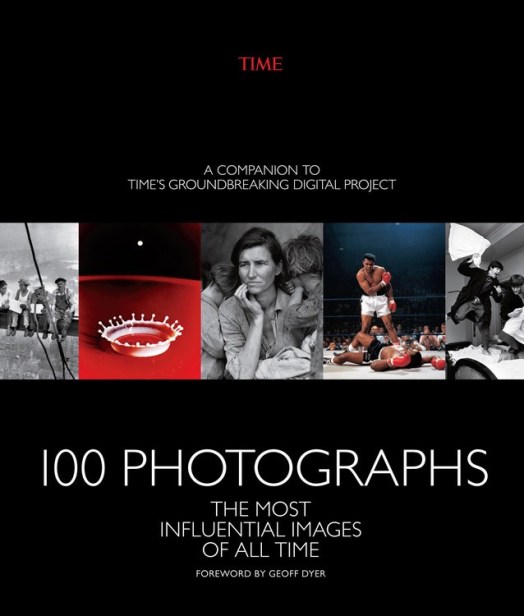 Almost none of this is true. The soldier in the image wasn’t Riley; Capa stayed for less than 30 minutes; and no evidence indicates that LIFE’s “general manager” stopped the presses for this story. I do note with pleasure, however, that the writers avoided claiming that any of Capa’s negatives got ruined in the lab. That’s progress.
Almost none of this is true. The soldier in the image wasn’t Riley; Capa stayed for less than 30 minutes; and no evidence indicates that LIFE’s “general manager” stopped the presses for this story. I do note with pleasure, however, that the writers avoided claiming that any of Capa’s negatives got ruined in the lab. That’s progress.
The piece then presents the problematic Time video of 2014, also filled with misinformation.
This video was produced in conjunction with a book by the same title, published in October 2016. — A. D. C.]
(Part 1 I 2)
•
(For an index of links to all posts in this series, click here.)



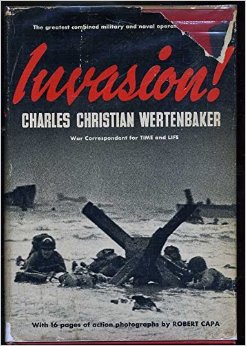


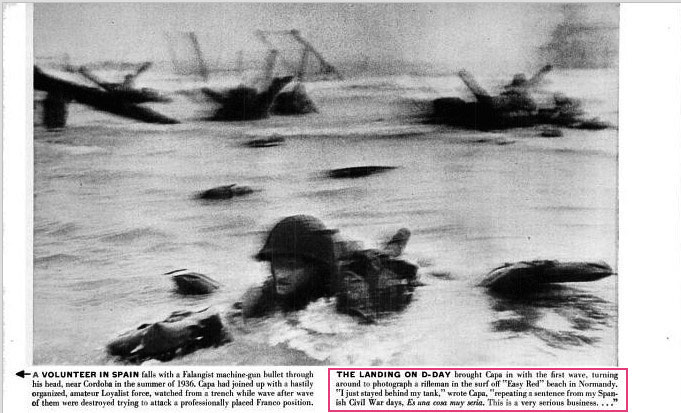
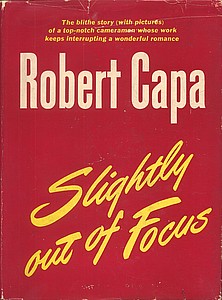
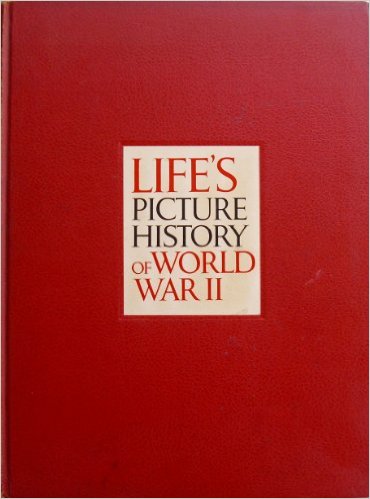
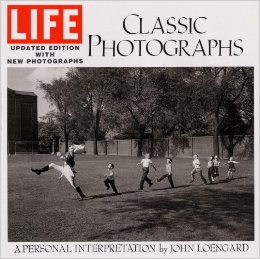
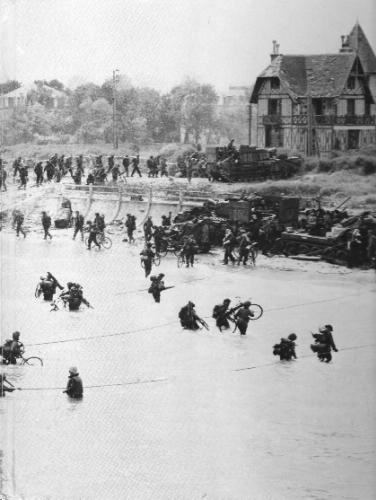
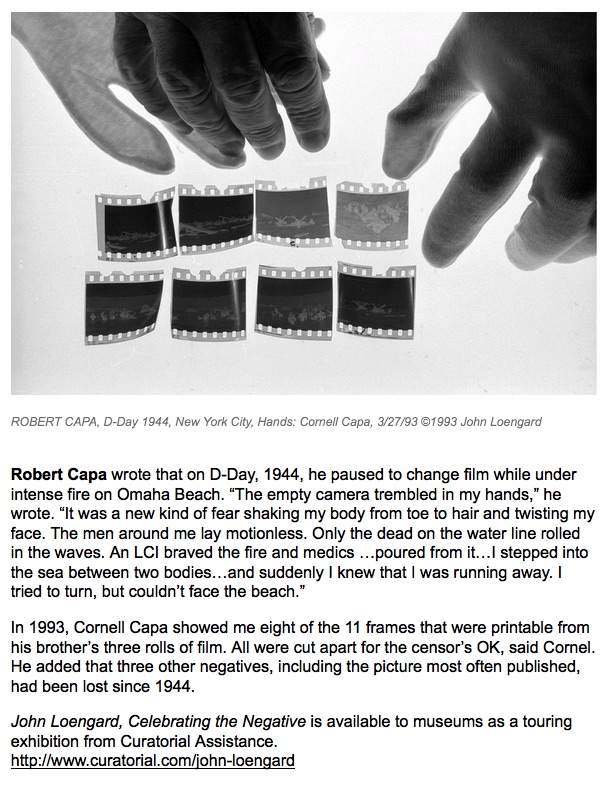
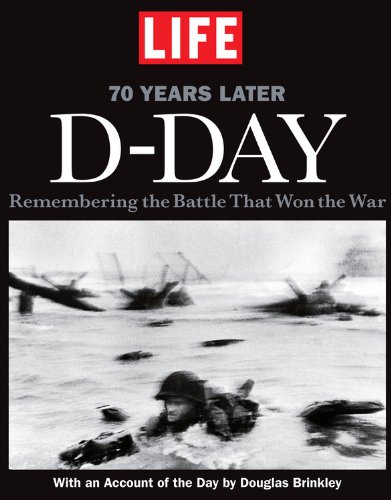
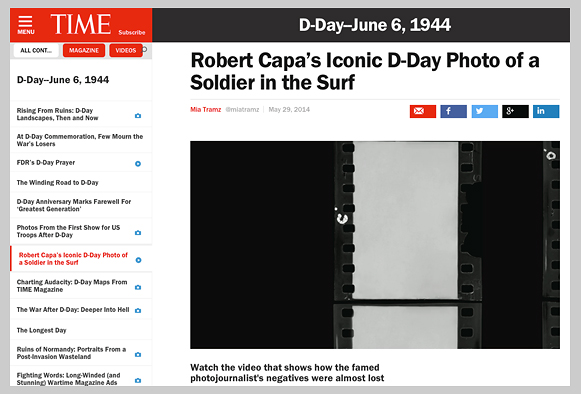
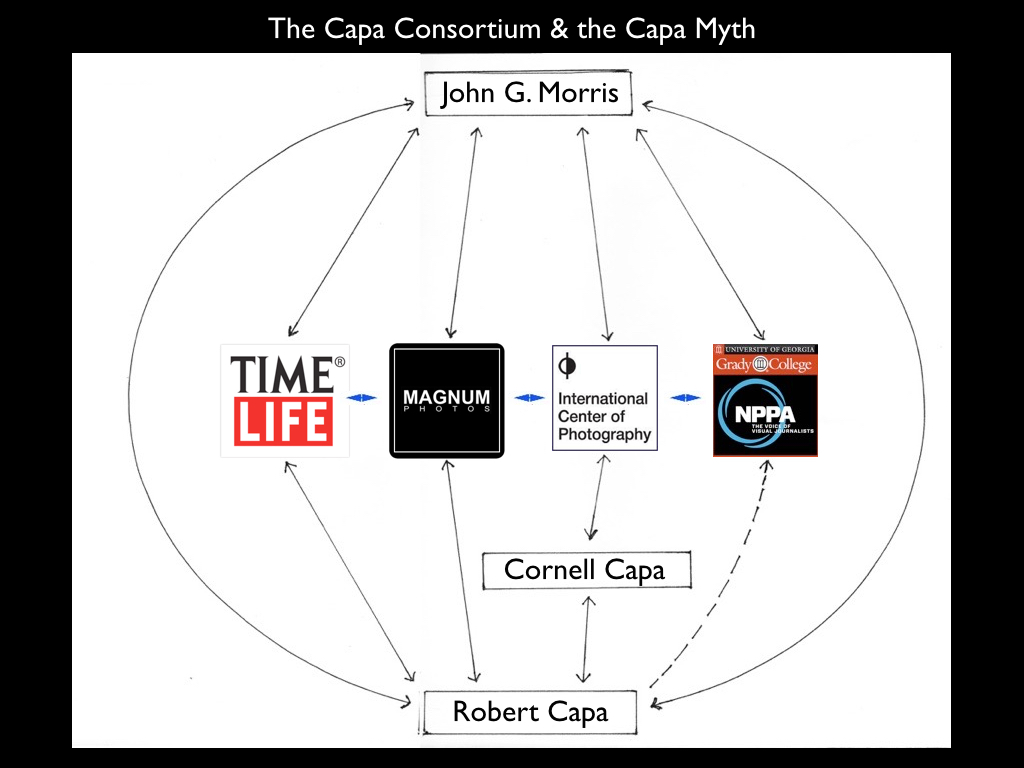




Larry Burrows died in 1971 in Laos, so could not offer his account (had anyone asked?) of working as an assistant in the Life photo lab in London in 1944 or his assessment of the forensic premise used as an explanation by Capa and Morris. BUT, he went to work there at age 16 in 1942, making him 18 at the time of the ‘accident’, not young enough or inexperienced enough (2 years working in the lab) to flub the drying process as described.
Who, how and why was he fingered as the guilty party long after the event and, conveniently, after his death? Where did that accusation come from? In Burrows Wikipedia bio this footnote states: “Morris blames it on a young developer named Dennis Banks. John G. Morris, “Get the picture, A personal history of photojournalism”, Random House Inc, N-Y 1998″.
So, after 1971, it seems the only ‘reliable source’ is John Morris as the only ‘eye witness’, since all other possible 1st hand witnesses were now dead. Thus the myth could be safely adopted and published without any personal contradictions. Methinks that Time/Life did not publish the fable ‘officially’ until after those professionals with living memory of WWII were gone (thus avoiding liability and embarrassment)…all except Morris, who could then freely inoculate the living with his peculiar ethical virus and have no worry of an antidote to spoil the story.
Just sayin….
I have not come across any recorded commentary by Burrows in relation to that rumor.
From what I can piece together, Burrows’s name got connected to the supposed darkroom disaster simply because he was there that night — though not involved in any darkroom activity, simply as an errand boy — and later became famous. LIFE staff photographer David Douglas Duncan apparently named him as the culprit in some public statement (on what basis I can’t say, since Duncan wasn’t there) while Burrows still lived. Whereupon Morris felt obligated to deny publicly that Burrows was responsible. Eventually he fingered Banks for the mishap.
The fact that TIME’s commemorative book D-Day: 24 Hours That Saved the World, published in 2004 and reissued twice since, asserts that “the guilty assistant was Larry Burrows,” shows how what Norman Mailer called “factoids” persist and get spread even by reputable journalists and periodicals.
For comic relief … I came across one amateur blogger who, standing this rumor on its head, asserted that, after ruining Capa’s D-Day films, Dennis Banks went on to have a distinguished career as a war photographer himself.
Dunno?
I don’t believe Capa “bugged out after snapping only 11 frames.” The only way that would happen is if Capa was known for being very anal and stingy shooting pix and then did decided to call it quits.
I shot my artists’ book Gay Bar in about 45 minutes at 4 bars.
I shot undercover with infrared flash. I took almost a couple hundred pix in 45 min of shoot time. OK, it was digital and not film, but I had to be low key and could not shoot freely.
If I could shoot without worries, I would have shot triple that amount or more. Point being, what kind of photog puts all that time in getting there, is there and then and only takes 11 pix?
The simple answer: One who had a panic attack. I strongly recommend that you actually read the research we’ve published. You might start with the posts by Pulitzer Prize-winning photojournalist J. Ross Baughman, who initiated this investigation in June 2014 by casting doubts on what was then the standard story of Capa’s D-Day activity.
For what it’s worth, even John Morris, Capa’s picture editor at LIFE, has acknowledged on Christiane Amanpour’s CNN show that Capa likely remained on Easy Red for less than half an hour and while there made only the ten exposures of which we have tangible evidence.